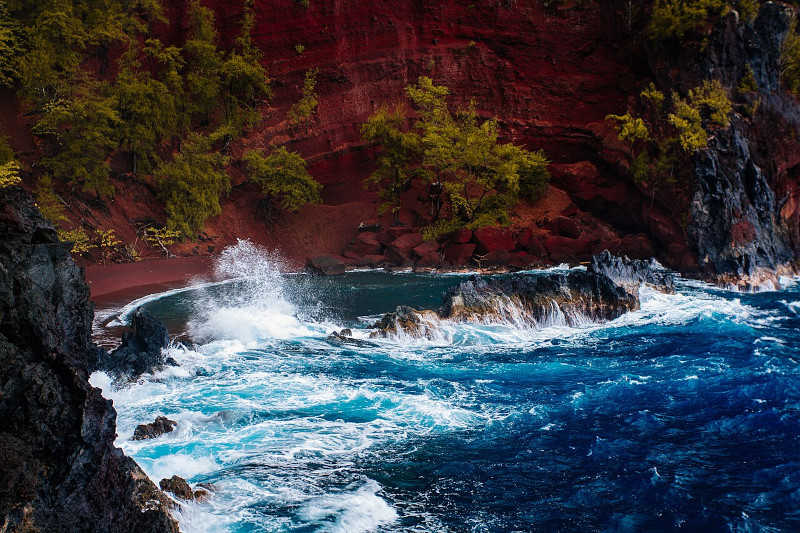
Kaihalulu Beach Facts
- This stunning masterpiece of time and geological processes most frequently goes by the local common name of Kaihalulu Beach. Yet, it also has another accepted general title. That’s the fully descriptive english language label of Red Sand Beach.
- The local Indigenous Peoples gave it the appellation still most often used today. They did so, however, unknown centuries before the arrival of European explorers. In their native tongue, it’s a derivative of kai halulu, which means roaring sea.
- Archaeological evidence indicates that the initial discovery of the islands, and subsequently this individual feature, took place due to explorations by Polynesian sailors. That same evidence also places that arrival at sometime between 1219 -1266 AD.
- The first known sighting of the island on which it sits by outsiders occurred in 1778. At that time, English explorer James Cook first spotted it. It’s not recorded if he noted this particular beach, though. Exactly who holds that distinction remains unknown.
- Despite its intoxicating beauty and distinctiveness, Kaihalulu Beach remains relatively sparsely visited compared to other beaches in its region. That’s because of the nature of the surrounding landscape. The nature of this requires an extremely hazardous hike.
- This short trip also requires crossing private property, though local law prevents private entities from refusing permission to access it. In a way, however, these provide the extraordinary feature with a measure of protection from the depredations of man.
Related Articles
Kaihalulu Beach Physical Description
The marvelous Kaihalulu Beach instantly captivates and awes those few fortunate enough to visit the site itself. The feature does so, however, due more to its natural beauty than sheer size. That’s due to the fact that Nature packed all that splendor into a small package.
It qualifies as what’s known as a pocket beach. This means it formed as isolated between two headlands. Formations meeting this status typically develop as small, as this one did. Its exact dimensions vary, though, due to the actions of local tides, which can be strong.
Nature additionally created this magnificent site with a strongly present crescent shape. This too owes its existence due to the actions of the powerful waves present. Measurements of the beach further indiciate that it continues to increase in size, albeit quite slowly.
The most striking feature of Kaihalulu Beach for most people is unquestionably the sand itself. That’s because of its eye-catching color. This consists of a highly distinctive deep red-black shade. That contrasts incredibly with the deep blue of the surrounding waters.
Not simply stopping there, though, its marvels continue. Surrounding the beach itself the viewer notices looming, volcanically formed, jet-black walls. Offshore, neneath the water’s surface, lies yet another aspect. Large rocks, also volcanic in origin, form a natural seawall.
Kaihalulu Beach Location, Formation, and Ecology
Nature created the otherworldly beauty of Kaihalulu Beach in a relatively isolated section of the surface of the earth. The precise location of that section probably won’t surprise many people, though. That’s true since it formed on one of what’s now the Hawaiian Islands.
Officially forming a member state of the United States, this archipelago, itself amazing, lies within the confines of the North Pacific Ocean. One of many beaches found here, it sits on the island of Maui. There, the marvel is situated on the approximate eastern coast.
Like the entire gorgeous archipelago itself, this captivating structure owes its formation to volcanic activities. Research indicates that the creation of the overall island chain began roughly 28 million years ago. That action continued on and off over a great expanse of time.
Indeed, it remains ongoing. The youngest island of the group appears to be only roughly 400,000 years old. The same studies also indicate that Maui shares the same general period of time for its creation. Formation of the lovely beach thus shares this general period.
It essentially sits at the base of an ancient cinder cone, just south of Hana Bay. Due to local environmental conditions, the walls of this continually erode. This action constantly replenishes, and even enlarges, the beach. It also accounts for the color, being rich in iron.
Given its very nature, Kaihalulu Beach possesses very little direct ecology. Several locally prevalent species of seabirds frequent the skies above it, thugh, and often land momentarily on its shores. These avians bear the names of ‘iwa and Koae Kea in the Polynesian tongue.
Features Sharing Its Region
Check out our other articles on 3 Surprising South American Moths, Striped Skunk, Great Barrier Reef, American Sweetgum, Wolf Eel, Fire Salamander, Mountain Apollo, Hermann’s Tortoise
